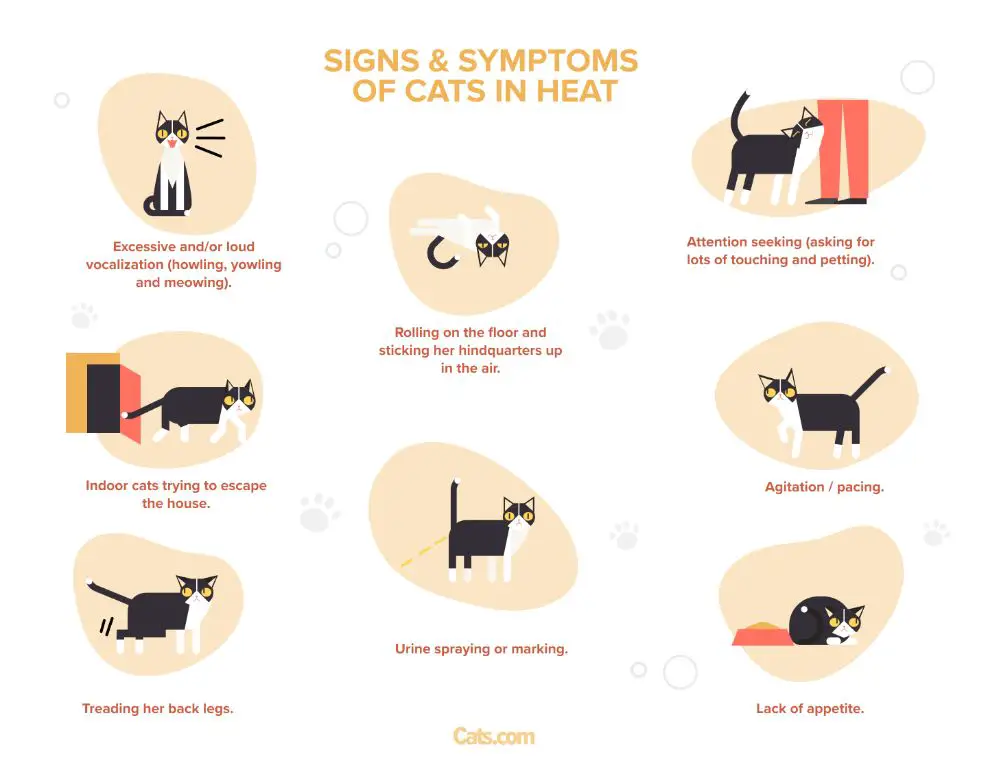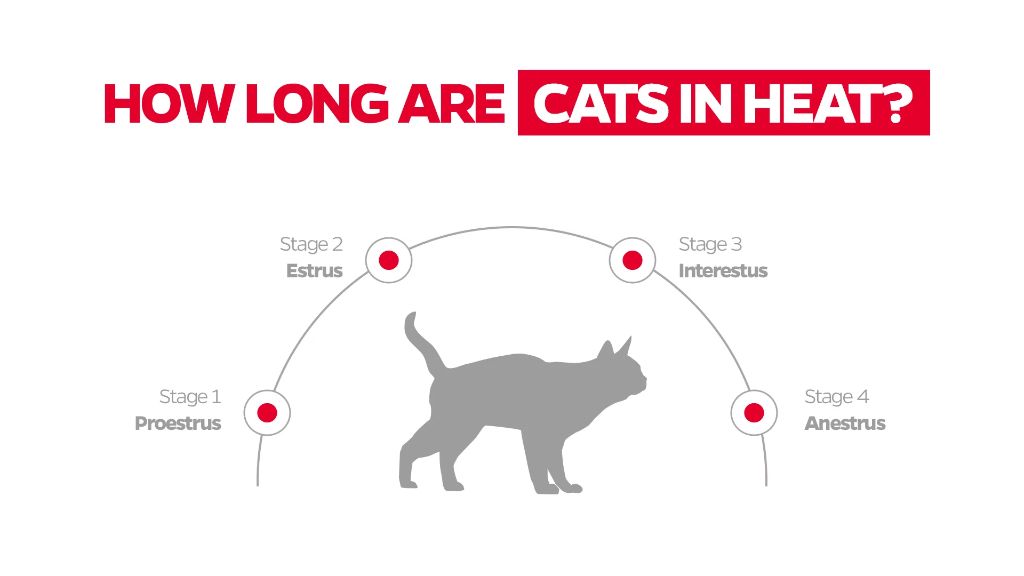A heat cycle, also known as an estrous cycle, refers to the reproductive cycle that female cats go through when they are able to get pregnant. During this time, cats undergo behavioral, physiological and anatomical changes as their bodies prepare for mating and potential pregnancy. The purpose of this article is to provide a comprehensive overview of the feline heat cycle, with a focus on explaining if and why cats bleed when they are in heat.
Understanding the heat cycle in cats is important for pet owners. By knowing what to expect, owners can better monitor their cat’s health and behavior during this time. Additionally, being aware of the heat cycle can help owners make decisions about spaying or breeding their cat. This article will cover the signs of heat, the different phases, if and why bleeding occurs, what amount of bleeding is normal, how to monitor it, and more. The goal is to provide cat owners with helpful information to understand what their cat experiences during her heat cycles.
Signs of Heat
When a cat goes into heat, there are several noticeable physical and behavioral changes. According to Vetic (2023), the most obvious signs that a female cat is in heat include increased vocalization, restlessness, and affectionate behavior towards people or objects. Cats in heat tend to become very loud, with more meowing, howling, and caterwauling. They may rub up against furniture, people, or other animals more frequently. Excessive licking, grooming, and hair loss on their hindquarters may occur as cats continuously lick those areas. Appetite changes are also common, with some cats eating less during heat.
There are also physical signs of heat in cats. Enlargement of the vulva and rippling skin movements in the pelvic area indicate the cat is in heat. Cats will adopt the mating stance, lowering their front halves down while keeping the rear end upturned. This posture permits mating while also allowing males to smell hormonal changes. Frequently changing resting spots around the house is another sign, as cats become restless and struggle to get comfortable (Reveal Pet Food, 2023). Overall, vocalization, affection, restlessness, mating behaviors, and physical changes to the hindquarters are clear signs a cat is in heat.
Phases of the Heat Cycle
The feline heat cycle consists of four distinct phases:
Proestrus
This initial phase can last anywhere from 1-2 days to 2 weeks. In proestrus, estrogen levels start to rise and eggs in the ovaries begin to mature. There are usually no noticeable signs during this time. According to VCA Animal Hospitals, some cats may show mild behavioral changes like rubbing, rolling, orread here: Cat Heat Cycle – Companions Spay & Neuter Clinic.
Estrus
This phase typically lasts 4 to 10 days. Estrus is characterized by the female cat’s receptiveness to mating. Behavioral signs include raising hindquarters, treading with the back legs, and vocalizing. The vulva will swell and bleed a small amount. The queen will attract potential mates but is likely to reject them until late in this phase.
Interestrus
This non-receptive period after estrus may last 30-40 days on average. Hormone levels gradually return to normal. The vulva size and discharge will decrease.
Anestrus
This quiescent period where the cat shows no signs of heat may vary from 4 weeks to several months. This phase ends when proestrus begins and the next heat cycle starts.
Do Cats Bleed When in Heat?
Most female cats do not bleed when they are in heat. This is because cats undergo estrous cycles rather than menstrual cycles. In estrous cycles, the uterine lining is reabsorbed rather than shed, so there is no menstruation or external bleeding (1).

However, some female cats may experience a small amount of vaginal bleeding during an estrus cycle. According to veterinarians, around 10% to 15% of unspayed cats have vaginal discharge containing blood when they are in heat (2). The amount of blood loss is usually very minor, just a few drops. Excessive or prolonged bleeding is abnormal and warrants a veterinary visit (3).
So in summary, the vast majority of female cats do not visibly bleed while in estrus. But a small portion may have scant bloody discharge during their heat cycle.
Sources:
(1) https://www.thesprucepets.com/when-your-cat-is-in-heat-552170
(2) https://basepaws.com/blog/do-cats-have-periods-what-to-expect-during-a-female-cat-s-cycle
(3) https://www.myfamilyvets.co.uk/female-cat-in-heat
Why Do Cats Bleed in Heat?
Though uncommon, some female cats may experience light vaginal bleeding while in heat. This is usually caused by hormonal changes in the cat’s body that occur during estrus.
When a cat enters her heat cycle, levels of estrogen rise rapidly in the body. This causes the lining of the uterus, known as the endometrium, to proliferate and thicken in preparation for pregnancy and nursing kittens.

In some cats, small amounts of blood from the thickened uterine lining may be discharged through the vagina. This is similar to menstruation in human females. However, cats do not shed the entire uterine lining at once like humans do. Instead, the endometrium is reabsorbed if the cat does not become pregnant during that cycle.
The rise in estrogen also increases blood flow to the reproductive organs, which can sometimes lead to minor vaginal bleeding as well. The amount of discharge is usually very small – just a drop or two.
Excessive or prolonged bleeding is abnormal and may indicate an underlying health issue requiring veterinary attention. But a small amount of blood mixed with clear or brownish vaginal discharge is often normal for a cat in heat.
When to Expect Bleeding
Female cats typically only experience vaginal bleeding during the estrus phase of their heat cycle. This is because estrogen levels peak during this time, causing the bloody discharge. According to The Spruce Pets, the estrus phase begins about 1-2 days after the onset of heat and can last anywhere from 2-19 days, with an average of about 6-8 days.

During this estrus period, the bloody discharge occurs because the uterine lining thickens in preparation for pregnancy. If no pregnancy occurs, the lining breaks down and sheds, resulting in the bloody vaginal discharge. The bleeding is usually light at first but can become heavier mid-cycle before tapering off again toward the end. Owners may see spots or streaks of blood around the house from their cat’s normal grooming activities.
It’s important to note that not all cats will visibly bleed when in heat. According to Basepaws, around 25% of cats reabsorb the uterine lining instead of shedding it, so there is no external vaginal bleeding. However, most unspayed female cats will bleed during estrus at some point in their cycles.
Amount of Bleeding
Typically, cats bleeding while in heat is very small in amount. According to The Spruce Pets, most female cats do not visibly bleed at all when in heat, though some may have a small amount of bloody vaginal discharge.
My Family Vets notes that any vaginal bleeding in cats is usually very minor during estrus. A few drops of blood may be visible, but extensivevisible bleeding is uncommon.
Basepaws explains that since cats reabsorb their uterine lining instead of shedding it, there is usually no menstruation. While a small amount of bloody discharge can sometimes occur, significant external bleeding is very rare in cats.
Monitoring the Blood
It’s important to monitor your cat’s bleeding during her heat cycle to look for any abnormalities that may require veterinary attention. Some key things to look for include:
- Excessive bleeding that soaks through bedding or leaves spots around the house
- Bleeding that lasts more than 10 days or occurs outside of the heat cycle
- Bleeding accompanied by lethargy, weakness, or other concerning symptoms
- A foul odor or unusual color to the blood
- Presence of blood clots or tissue in the blood
Minor bleeding during a normal heat cycle is expected, but excessive bleeding or bleeding that continues for an extended period could signify an underlying health issue. It’s best to contact your veterinarian if you notice anything abnormal about your cat’s bleeding habits or the characteristics of the blood itself.
Treating Excessive Bleeding
If your cat is bleeding excessively during her heat cycle, it’s important to seek veterinary care right away. Excessive bleeding can quickly lead to anemia and other complications if left untreated. Some key treatments your vet may recommend include:
Exam and Diagnostic Tests – The first step is a full exam to check your cat’s overall health, look for any injuries, and determine the cause of bleeding. Your vet may run tests like a complete blood count, urinalysis, imaging, or vaginal cytology to check for issues like infection or uterine disease.
Medications – Your vet may prescribe medications to help control bleeding and address any underlying problems. Common medications include antibiotics for infection, anti-inflammatories for uterine inflammation, and omega fatty acids to improve uterine health.
Emergency Spay – If your cat is bleeding profusely and medical management does not stop the bleeding, emergency spay surgery may be needed. This involves surgically removing the uterus and ovaries to stop the bleeding. It carries risks but can be life-saving in severe cases of uncontrolled bleeding.
Routine Spay – Once your cat recovers from any emergency treatment, your vet will likely still recommend spaying her. Spaying prevents future heats and bleeding episodes and eliminates the risk of serious uterine infections.
Preventing Future Heats
The best way to prevent a cat from going into heat again is to spay (ovariohysterectomy) them. Spaying refers to the surgical removal of the female reproductive organs (ovaries and uterus). It is a safe, routine procedure normally done when a cat is 6-9 months old before her first heat.

There are many benefits to spaying a cat:
- Eliminates the ability to go into heat cycles and unwanted litters – Spaying prevents pregnancy and stops the bothersome behaviors associated with going into heat.
- Reduces certain health risks – Spayed cats have a greatly reduced risk of mammary cancer and completely eliminates the risk for pyometra (a serious, life-threatening uterine infection).
- Reduces undesirable behaviors – Spaying can reduce urine marking, roaming, and aggression in female cats.
- Increases lifespan – Spayed cats live on average 39% longer than intact cats.
Overall, spaying is highly recommended by veterinarians for its health and behavioral benefits. It is a one-time cost that provides long-term benefits for a cat’s quality of life. Be sure to talk to your vet about the ideal timing to spay your cat.

